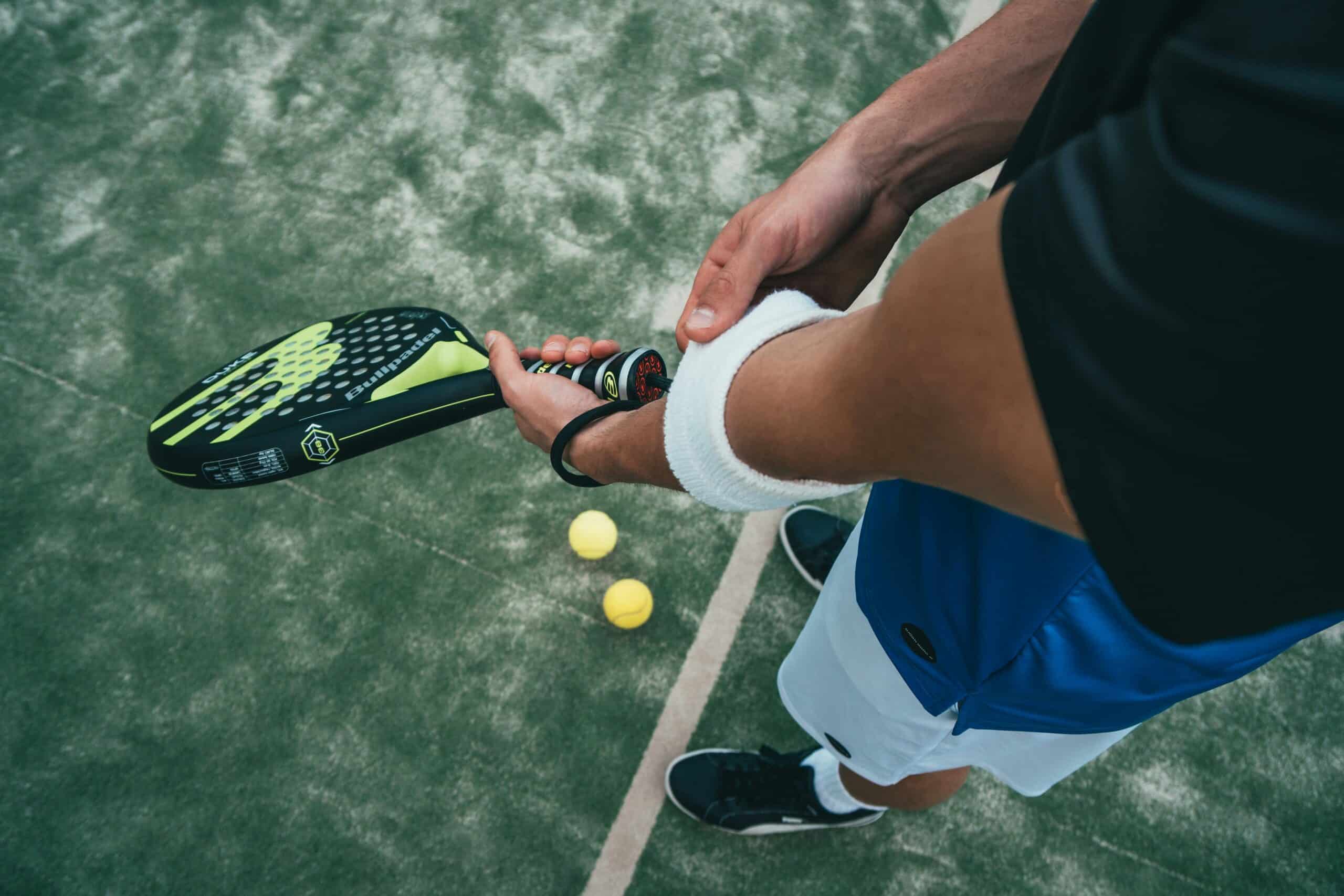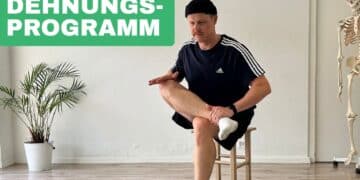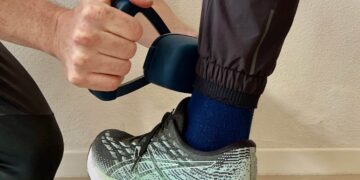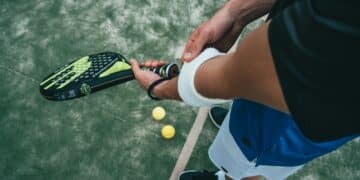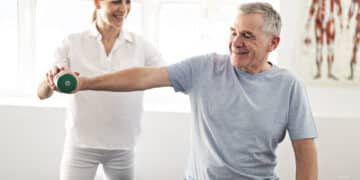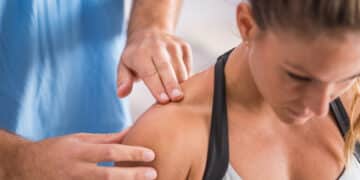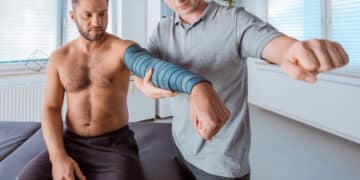Tennis elbow can severely restrict your mobility and cause unpleasant pain in the elbow. This discomfort, often referred to as Epicondylitis are not just limited to athletes - everyday activities can also be affected. In this blog post, you will learn how we at our clinic can help you understand the causes and apply effective treatment methods to regain your quality of life. Let's discover together the information that will help you achieve a pain-free hand and an active lifestyle!
The causes of tennis elbow: Overuse and injuries
Tennis elbow or golfer's elbow - what are the differences?
Tennis elbow, also known as lateral epicondylitis, can cause significant discomfort in the elbow and can be caused by overuse during activities such as tennis. The typical symptoms are pain on the outside of the elbow, which can radiate into the forearm and hand. Treatment involves various methods to relieve the inflammation and restore mobility. Physiotherapy plays a central role, involving targeted exercises to strengthen and stretch the muscles. In some cases, injections may also be necessary to relieve pain. Those affected should also take care to adapt their activities to prevent further discomfort. Information on preventive measures is crucial to prevent relapses. Our team at the clinic will be happy to provide you with individual advice and support. With the right treatment and a patient-centered approach, you can soon be active again without pain and achieve your sporting goals.
The causes of tennis elbow: Overuse and injuries
Tennis elbow is often caused by repeated overuse, which can lead to inflammatory processes in the elbow. This overuse often results from sports such as tennis, where the hand and arm are subjected to heavy strain. The main symptom is a sharp pain on the outside of the elbow, which intensifies with movements such as gripping or lifting objects. Those affected often complain of pain that can spread to the shoulder or forearm. Early diagnosis and targeted treatment are important to alleviate the symptoms.
At a clinic, patients receive information about suitable therapies, including physiotherapy and special exercises to strengthen the muscles. The aim is to restore the function of the arm and reduce the sensation of pain. An individual treatment strategy can help you to manage your symptoms effectively and return to your usual mobility as quickly as possible.
Symptoms and diagnosis of tennis elbow
Tennis elbow often manifests itself as pain and discomfort in the elbow area, which can spread to the shoulder and hand. Those affected report a stinging or burning sensation that is particularly noticeable when making movements such as gripping or turning the arm. These symptoms may indicate inflammation of the tendon insertions on the outer elbow, often in conjunction with epicondylitis. Timely diagnosis is important in order to avoid consequential damage. With the help of special tests and palpation, the physiotherapist can determine the exact cause of the pain and draw up an individual treatment plan. The therapy can include effective measures such as physiotherapy, targeted exercises and, in certain cases, injections. It is helpful to obtain information on preventive measures to avoid tennis elbow in the future. If you have any questions or complaints, we will be happy to help you at the clinic. An active exchange is the first step towards relieving pain and restoring mobility.
Treatment options for tennis elbow: from physiotherapy to injections
The treatment options for tennis elbow are varied and tailored to the individual symptoms of the person affected. One of the most effective methods is physiotherapy, which includes targeted exercises to improve mobility in the elbow and strengthen the muscles. The Trigger point therapy IMTT® can be used to relieve tension and alleviate pain. In some cases, an injection of anti-inflammatory medication is required to reduce swelling and inflammation. These include corticosteroid injections, which can provide rapid relief. In addition to active treatment methods, learning ergonomic techniques also plays a role in avoiding strain. It is important to obtain information about suitable treatment approaches in good time. At our clinic, we offer you comprehensive support so that you can return to pain-free activity as quickly as possible with targeted measures.
Tennis elbow prevention: tips for athletes and recreational players
To prevent tennis elbow, it is important to take targeted measures. Regular stretching and strengthening exercises for the arm, especially for the muscles around the elbow, can help to prevent overuse. When playing sports, whether tennis or golf, make sure you use the correct technique to reduce the strain on the joints. A good warm-up phase before the game and sufficient breaks during the activity are also important. At the first sign of discomfort, you should react immediately to prevent inflammation. Cooling the affected area and wearing elastic bandages can provide relief. At our clinic, we offer you comprehensive information on effective prevention strategies for tennis elbow. Our experts are always available to help you if the pain persists and to customize exercises. Get in touch with usto sustainably support your mobility and minimize discomfort.
Golfer's elbow: causes and differences to tennis elbow
Golfer's elbow, also known as golfer's elbow, differs significantly from tennis elbow in terms of its causes and symptoms. While the main cause of tennis elbow is overuse of the muscle insertions on the outside of the elbow, the inner insertions are affected in golfer's elbow. This leads to pain and inflammation, which typically occurs when gripping or rotating the hand. Those affected often describe symptoms that can radiate into the shoulder. In order to find suitable treatment options, a comprehensive assessment by specialists in a clinic is of great importance. Physiotherapy can help to specifically strengthen the muscles and alleviate pain. Anti-inflammatory measures and, if necessary, injections are also recommended in order to treat the symptoms effectively. In the case of acute symptoms, it is advisable to contact a specialist at an early stage in order to avoid long-term restrictions and return to normal mobility as quickly as possible.
Solutions for golfer's elbow: effective treatment methods
Golfer's elbow, also known as golfer's elbow, often causes considerable discomfort in the elbow area. Early and targeted treatment can make a decisive contribution to alleviating the pain. Proven therapeutic approaches include IMTT® trigger point therapy, manual therapy and physiotherapy measures aimed at improving the mobility of the arm and reducing inflammation. In addition, specific exercises can help to strengthen the muscles and prevent renewed overloading. In our practice, experienced therapists are on hand to create an individual treatment plan tailored to your needs. For acute pain, drug therapy in combination with injections may be considered to provide immediate relief. Don't hesitate to contact us for more information and to work together on solutions for your golfer's elbow.
Conclusion: Tennis elbow and golfer's elbow - back to mobility with the right support!
Tennis elbow, also known as lateral epicondylitis, often causes considerable discomfort in the elbow and frequently radiates to the shoulder or hand. The pain is caused by overloading the tendons and muscles that attach to the elbow. Targeted treatment is of great importance to alleviate the inflammation and restore mobility. Physiotherapy plays a key role here, as it can help to strengthen the muscles and relieve tension through special exercises and techniques. In severe cases, injections may be considered to reduce pain and promote healing. It is important to act promptly and contact a clinic if symptoms persist. This will help affected individuals find solutions quickly and provide valuable information to best support their recovery. Taking an early step towards treatment can make the path back to an active lifestyle much easier.
References
Categories
- Osteoarthritis
- Leg
- Extensions
- Dry needling
- Elbow
- Foot
- Balance
- Hand
- Hip
- Pine
- Knee
- Headache
- Lymphatic drainage
- Mobilization
- Muscle pain
- Myofascial therapy
- Neck pain
- Physiotherapy Höngg
- Physiotherapy Wipkingen
- Physiotherapy Zurich
- Rehabilitation
- Back pain
- Shoulder arm
- Shoulder pain
- Pregnancy
- Dizziness
- Sports
- Trigger points
- Exercises
- Lower leg
- Injury prevention
- Wade
- What to do?
- Wound healing
People have asked
Tennis elbow, also known as lateral epicondylitis, can be alleviated with targeted measures. First of all, it is important to rest the affected area and avoid overloading it. Cold applications, such as ice packs, can help to reduce pain and swelling. Physiotherapy plays a crucial role in treatment. Various techniques are used here, such as trigger point therapy IMTT®, which specifically treats tense muscles and promotes blood circulation. In addition, targeted strengthening and stretching of the forearm muscles can be carried out to increase flexibility and strengthen the muscles. Manual therapy and lymphatic drainage can also help to improve mobility and promote the healing process. In more severe cases, medical intervention may be necessary, such as injections or surgical treatment. Another important aspect is the adaptation of sporting activities. Make sure you use the correct technique and, if necessary, use aids to reduce the strain on the arm. Regular breaks and targeted warm-up exercises can also help to prevent tennis elbow and aid recovery.
Tennis elbow, also known as lateral epicondylitis, is a common injury that is typically associated with pain in the elbow area. This condition results from overuse and repetitive strain on the tendons that attach to the outer epicondyles of the humerus. Although the term "tennis elbow" suggests that the condition is caused solely by playing tennis, it can also be caused by other activities that require similar movements, such as lifting heavy objects or working at a computer. The inflammation associated with tennis elbow usually affects the tendons responsible for extending the wrist. This leads to pain that can radiate into the forearm, as well as limited mobility. In addition to inflammation, microscopic tears can also occur in the tendon structures. Early diagnosis and appropriate treatment measures, such as physiotherapy or specific exercises, are crucial to promote healing and alleviate symptoms. In severe cases, surgical intervention may also be necessary to repair the affected tendons.
If tennis elbow, also known as lateral epicondylitis, is not treated, the symptoms can worsen considerably. Initially, there may be mild pain and limited mobility. However, without appropriate measures, the pain can become chronic and spread to the entire arm. This often leads to difficulties with everyday activities, such as lifting objects or gripping utensils. In the long term, an untreated injury can lead to a weakening of the muscles and reduced functionality of the arm. In severe cases, it can lead to a condition known as "tendinopathy", where the tendon structure is damaged and becomes inflamed. This can lead to permanent pain and restricted movement. There is also a risk of the pain spreading to other areas of the body, such as the shoulder or neck, as the body tries to compensate for the pain. Early treatment is crucial to promote healing, restore mobility and improve quality of life.
The length of time it takes to heal from tennis elbow can depend on a number of factors, including the severity of the injury, the individual healing processes and the treatment methods used. As a rule, it can take several weeks to several months for the symptoms to subside completely. Initially, it is important to rest the affected area and take anti-inflammatory measures if necessary. Physiotherapy plays a crucial role in recovery. Targeted exercises to strengthen and stretch the muscles can improve the function of the arm. In many cases, those affected show a noticeable improvement after just a few sessions. Alternative treatment methods such as trigger point therapy or lymphatic drainage can also have a supportive effect. With consistent treatment and by following the therapist's advice, it is possible to significantly reduce symptoms and restore mobility. However, it is important to be patient, as every healing process is individual. Early diagnosis and appropriate treatment can have a positive effect on the healing process and speed up the return to the usual level of activity.
Stretching program
Your stretching program Stretching is an essential foundation for your mobility and well-being....
Read moreStrength measurement - We monitor your therapy success
Measuring strength in physiotherapy: A key to targeted and effective treatment The importance of measuring strength...
Read moreTennis elbow or golfer's elbow? Causes, symptoms and treatment
Tennis elbow can severely restrict your mobility and cause unpleasant pain in the elbow. This...
Read moreNeck pain - holistic therapy with trigger point therapy and active exercises.
Neck pain? Get active and free yourself! Do you know the feeling of waking up in the morning and feeling like a robot?
Read moreShoulder pain: causes, treatment, exercises
What is shoulder pain and how does it develop? Shoulder pain is one of the most common complaints of the musculoskeletal system...
Read moreWound healing phases
Have you ever wondered how our bodies miraculously repair injuries such as muscle tears, torn muscle fibers and...
Read moreUnderstanding shoulder osteoarthritis - symptoms and therapies
What is shoulder osteoarthritis? The shoulder joint consists of the humeral head and the glenoid cavity, both covered with cartilage.
Read moreFlossing for scar treatment: Innovative, effective and supportive
Have you ever heard of flossing? This innovative physiotherapy technique is becoming increasingly popular,...
Read more
